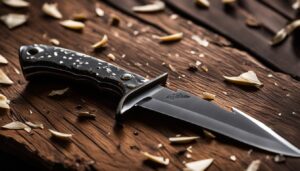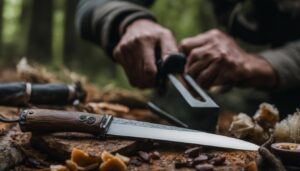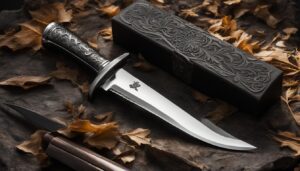Hunting requires the right equipment, and a reliable hunting knife with a high-quality edge is crucial for success and safety. A sharp blade that can handle a variety of tasks, from field dressing game to cutting through brush, is essential in the field. High-carbon steel blades are known for their excellent edge retention, making them ideal for hunting. The blade style, handle material, blade length, and sheath options are all important considerations when choosing a hunting knife.
Key Takeaways:
- Invest in a high-quality hunting knife with a sharp blade for successful and safe hunting.
- Consider the blade material, such as high-carbon steel, for excellent edge retention.
- Choose a blade style, like drop point or gut hook, based on the specific hunting tasks.
- Ensure the handle material provides a comfortable and secure grip, even in wet or cold conditions.
- Select a blade length suitable for the type of hunting and tasks involved.
Blade Material: Stainless Steel vs. High-Carbon Steel
When it comes to hunting knife blade material, two popular options are stainless steel and high-carbon steel. Each material has its own unique characteristics and advantages, catering to different hunting environments and personal preferences.
Stainless steel blades are known for their exceptional corrosion resistance, making them an ideal choice for hunters who frequently encounter wet or humid conditions. These blades are less prone to rust and staining, ensuring longevity and durability.
On the other hand, high-carbon steel blades are preferred for their excellent edge retention. They can maintain a sharp edge for longer periods, making them perfect for tasks that require precision and a razor-sharp blade, such as skinning game. However, high-carbon steel blades may require regular maintenance to prevent rust and corrosion.
The choice between stainless steel and high-carbon steel largely depends on the specific hunting environment and the hunter’s preferences. Some hunters prioritize corrosion resistance, while others prioritize edge retention and sharpness. Ultimately, selecting the right blade material ensures a high-quality hunting knife that performs optimally in the field.
| Blade Material | Corrosion Resistance | Edge Retention |
|---|---|---|
| Stainless Steel | High | Moderate |
| High-Carbon Steel | Moderate | Excellent |
Blade Style: Choosing the Right Design for Hunting Tasks
Hunting knives come in various blade styles, each suited for specific tasks. The three most common blade styles for hunting knives are drop point, clip point, and gut hook. Understanding the characteristics and uses of each blade style is essential in selecting the right knife for your hunting needs.
Drop Point Blade
The drop point blade is a versatile design that is widely popular among hunters. It features a convex curve on the spine, which creates a strong and durable tip. This blade style is well-suited for a wide range of hunting tasks, including skinning and slicing. The gradual belly of the blade provides excellent control and facilitates easy field dressing. Due to its versatility, the drop point blade is a solid choice for all-around hunting purposes.
Clip Point Blade
The clip point blade is characterized by a more acute tip, ideal for precision work. This blade style is commonly used for caping, detail cutting, and other tasks that require controlled and precise movements. The clip point design allows for better piercing ability, making it suitable for delicate operations. However, the tip of the blade may be more prone to breakage compared to other blade styles.
Gut Hook Blade
Some hunting knives feature a gut hook blade, designed specifically for opening and field dressing game without piercing the internal organs. The gut hook, located on the spine of the blade, allows for precise and safe cutting along the abdomen of the animal. This blade style simplifies the process of field dressing and reduces the risk of nicking organs. Hunters who frequently engage in gutting game may find the gut hook blade to be a valuable addition to their hunting toolkit.
When selecting a hunting knife, consider the type of hunting and the specific tasks you will be performing. The blade style should align with your intended use to optimize performance and ensure efficient and effective hunting. Whether you require a versatile drop point blade, a precise clip point blade, or the convenience of a gut hook blade, choosing the right blade style is essential for a successful hunting experience.
Hunting Knife Handle Material: Comfort and Grip for Hunting
When it comes to choosing a hunting knife, one of the key considerations is the handle material. The handle plays a crucial role in providing comfort and ensuring a secure grip, especially in challenging hunting conditions. There are several handle materials commonly used in hunting knives, each offering its own unique benefits.
Wood Handles
Wood handles are a popular choice among hunters for their classic and aesthetic appeal. They provide a natural and warm feel in the hand. Wood handles can vary in type, including walnut, birch, and various wood laminates. They offer a comfortable grip and can provide good traction even when wet, though they may require more maintenance compared to other materials.
Rubber Handles
Rubber handles are favored for their superior grip and durability. They are resistant to moisture and provide a secure hold even in wet or slippery conditions. Rubber handles often feature textured patterns or grooves that further enhance grip. Additionally, rubber handles can absorb shock, reducing hand fatigue during prolonged use.
Synthetic Handles
Synthetic handles, such as G10 and Micarta, are known for their durability and excellent grip. G10 is made of layered fiberglass, while Micarta is a composite material made of layers of fabric and resin. Both options offer exceptional resistance to moisture, chemicals, and temperature changes. Synthetic handles are lightweight, strong, and provide a reliable grip in various hunting situations.
Ultimately, the choice of handle material comes down to personal preference and the specific hunting conditions. Whether you opt for the timeless appeal of wood, the superior grip of rubber, or the durability of synthetic materials, prioritize a handle that provides a comfortable and secure grip to maximize your hunting experience.
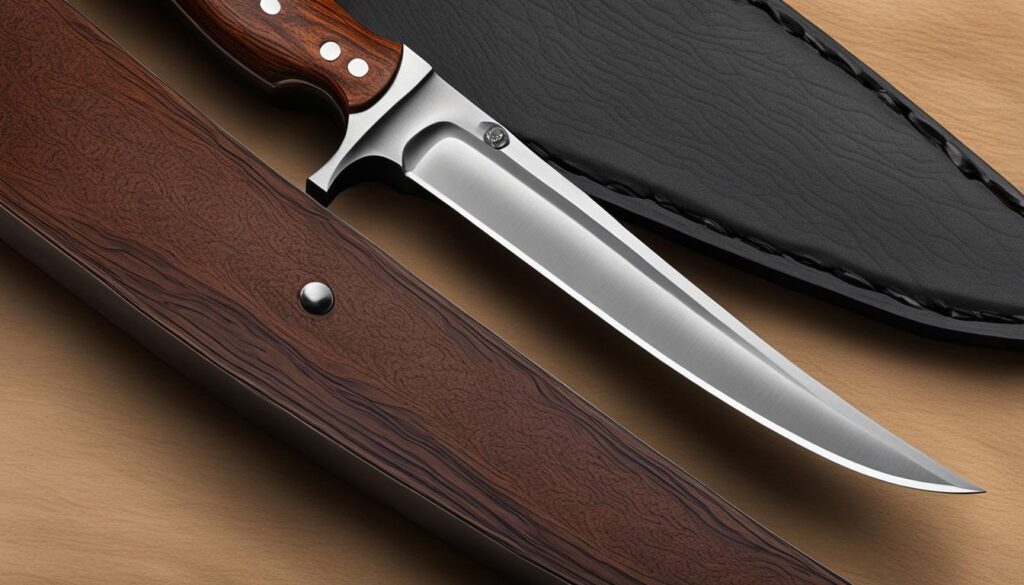
Blade Length: Choosing the Optimal Size for Hunting Tasks
When it comes to hunting, having the right blade length on your knife can make a significant difference in performance and versatility. The choice of blade length depends on the type of hunting tasks you’ll be undertaking and your personal preferences.
For general-purpose hunting, a blade length between 3 to 5 inches is often recommended. This range provides a balance between maneuverability and functionality, allowing you to perform a wide range of tasks with ease. Whether it’s field dressing game, cutting through brush, or preparing food in your campsite, a blade within this range offers the versatility you need for various hunting scenarios.
However, if you’re primarily targeting larger game, a longer blade may be preferable. A longer blade provides the necessary reach and cutting power to handle tougher tasks, such as quartering or removing hides from bigger animals. On the other hand, if you’re looking for a hunting knife that can handle a variety of tasks and be your go-to tool in different situations, a shorter blade offers more agility and versatility.
Ultimately, the choice of blade length comes down to your specific needs and preferences as a hunter. Consider the type of hunting you’ll be doing, the tasks you’ll encounter, and the level of versatility you desire. With the right blade length, you’ll have a hunting knife that enhances your performance and ensures you’re ready for whatever challenges the hunt brings.
Table: Blade Length Recommendations for Different Hunting Tasks
| Hunting Task | Recommended Blade Length |
|---|---|
| General-purpose hunting | 3 to 5 inches |
| Larger game | 5 to 7 inches |
| Versatile hunting | 3 to 6 inches |
Sheath and Carry Options: Ensuring Convenience and Safety
When it comes to hunting knives, the sheath plays a crucial role in ensuring convenient and safe storage. A high-quality sheath provides secure storage for your hunting knife, keeping it protected from the elements and preventing any accidental injuries. Additionally, a well-designed sheath allows for easy access to the knife when needed, reducing fumbling and saving valuable time in critical situations.
There are different carry options available for hunting knife sheaths, including belt carry and pack carry. Belt carry is a popular choice as it allows quick and easy access to the knife during hunting activities. With a secure belt loop attachment, the knife can be comfortably worn on the hip, providing immediate access when needed. On the other hand, pack carry is suitable for hunters who prefer to keep their hands free or require a more discreet approach. The sheath can be attached securely to a backpack or hunting pack, ensuring the knife is readily accessible while keeping it out of the way until required.
When choosing a hunting knife sheath, it’s essential to consider the material, construction, and overall design. Look for a sheath made from durable materials that can withstand outdoor conditions. Features like a secure retention system, such as a snap or strap, help keep the knife firmly in place while allowing for easy drawing when required. Some sheaths also include additional pockets or compartments for carrying small accessories like sharpening stones or fire starters, adding further convenience in the field.
A well-designed and reliable sheath not only enhances the safety and accessibility of your hunting knife but also offers peace of mind during your hunting ventures. It ensures that your valuable tool is always within reach, ready to assist you in various hunting tasks. Whether you opt for belt carry or pack carry, the right hunting knife sheath is an essential accessory for any hunter.
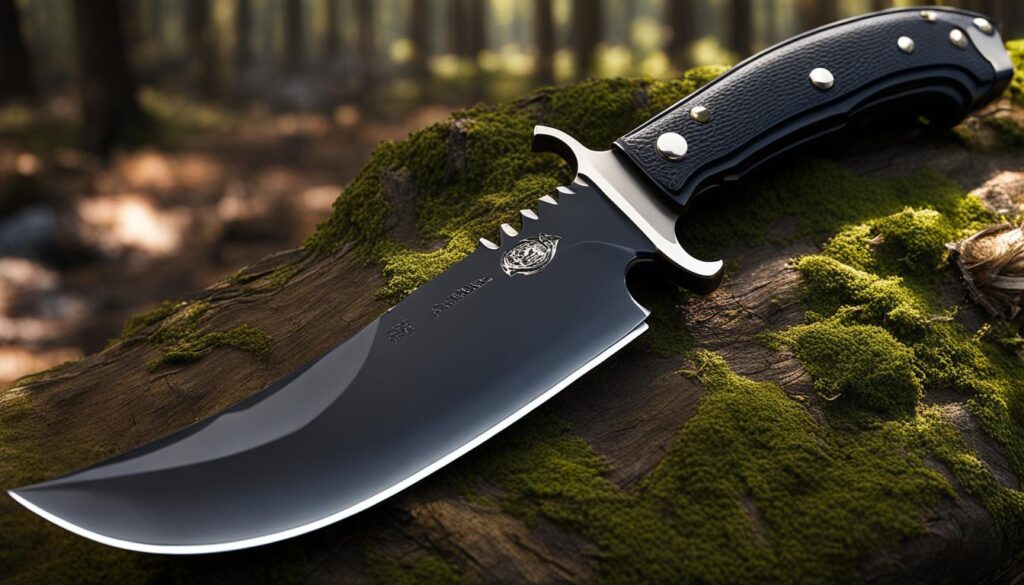

Table: Comparison of Sheath and Carry Options
| Sheath and Carry Option | Features | Suitability |
|---|---|---|
| Belt Carry | – Quick and easy access to the knife – Securely worn on the hip – Immediate availability during hunting activities |
Best option for quick access and convenience |
| Pack Carry | – Keeps hands free – Discreet carrying option – Attachable to backpack or hunting pack |
Ideal for hunters who prefer a hands-free approach or need a more discreet carrying method |
The Versatility of a High-Quality Hunting Knife
A high-quality hunting knife is a versatile tool that can handle a wide range of tasks in the field, making it an essential companion for any hunter. Whether it’s field dressing game, cutting through brush, or even survival situations, a well-crafted hunting knife can be relied upon to perform with precision and reliability.
When it comes to field dressing, a high-quality hunting knife makes the process efficient and clean. Its sharp edge allows for precise cuts, ensuring the removal of entrails and skinning with ease. With the right blade style, such as a drop point or gut hook, hunters can tackle these tasks effortlessly, without damaging the meat or piercing internal organs.
In addition to field dressing, a hunting knife with a fine edge is also adept at cutting through brush and foliage. Its razor-sharp blade can swiftly negotiate dense vegetation, clearing a path and allowing hunters to move with agility and speed. Whether it’s forging ahead or creating hunting blinds, a high-quality hunting knife is up to the challenge.
“A hunting knife is more than just a tool; it’s a trusted companion that enhances my skills as a hunter. From field dressing to survival situations, its versatility ensures I’m prepared for any scenario.”
Furthermore, in survival situations, a high-quality hunting knife can be a lifeline. It can be used for building shelters, preparing food, and even crafting tools for survival. Its durability and reliability make it indispensable in the wild, where every task becomes a matter of survival.
In conclusion, the versatility of a high-quality hunting knife cannot be overstated. It is a tool that transcends its primary purpose and becomes a valuable asset in a hunter’s arsenal. With its ability to perform a wide range of tasks such as field dressing, cutting through brush, and aiding in survival situations, a high-quality hunting knife is an investment that pays dividends in the field.
Conclusion
In conclusion, the importance of high-quality hunting knives cannot be overstated. The right blade material, style, handle material, blade length, and sheath options are all crucial factors to consider when choosing a hunting knife.
Having a sharp blade that can handle a variety of tasks is essential for successful and safe hunting. Whether it’s field dressing game, cutting through brush, or even survival situations, a high-quality hunting knife with the right blade material and style can greatly enhance a hunter’s capabilities in the field.
Additionally, the handle material should provide a comfortable and secure grip, allowing for precise control even in wet or cold conditions. The length of the blade should be suitable for the specific hunting tasks involved, offering the right balance between versatility and task-specificity.
Lastly, investing in a high-quality hunting knife ensures preparedness, safety, and success. By carefully considering the blade material, blade style, handle material, blade length, and sheath options, hunters can equip themselves with a tool that will serve them well in various hunting scenarios.
FAQ
Why is a high-quality hunting knife with a sharp edge important for successful hunting?
A high-quality hunting knife with a sharp edge is crucial for success and safety in hunting. It enables hunters to perform a variety of tasks, from field dressing game to cutting through brush.
What are the important factors to consider when choosing a hunting knife?
When choosing a hunting knife, important factors to consider include the blade material, blade style, handle material, blade length, and sheath options. These factors will determine the knife’s performance and suitability for specific hunting tasks.
What are the advantages of stainless steel and high-carbon steel blades?
Stainless steel blades are known for their corrosion resistance, making them ideal for hunters in wet or humid conditions. High-carbon steel blades, on the other hand, offer excellent edge retention, making them ideal for tasks that require a sharp edge, such as skinning game.
What are the different blade styles available for hunting knives?
The three most common blade styles for hunting knives are drop point, clip point, and gut hook. Each blade style is suited for specific tasks, such as skinning, precision work, and field dressing game.
What are the common handle materials used in hunting knives?
Common handle materials for hunting knives include wood, rubber, and synthetic materials like G10 and Micarta. Wood handles offer a classic and aesthetic appeal, while rubber and synthetic handles provide superior grip and durability.
How should I choose the blade length for a hunting knife?
The choice of blade length depends on the specific hunting tasks involved. For general-purpose hunting, a blade length between 3 to 5 inches is recommended. Longer blades are better suited for larger game, while shorter blades offer more versatility for a variety of tasks.
What should I consider when choosing a sheath for a hunting knife?
The sheath that comes with a hunting knife should ensure safe storage and easy access. Consider the quality and design of the sheath, as well as its carrying options (such as belt or pack carry) to ensure convenience and safety.
What tasks can a high-quality hunting knife be used for?
A high-quality hunting knife with a sharp edge can serve a wide range of tasks in the field. It can be used for field dressing game, cutting through brush, and even in survival situations if needed. Its versatility greatly enhances a hunter’s capabilities and preparedness.
What are the key factors to consider when choosing a hunting knife?
When choosing a hunting knife, it’s important to consider the blade material, blade style, handle material, blade length, and sheath options. Investing in a high-quality hunting knife ensures preparedness, safety, and success in hunting endeavors.


